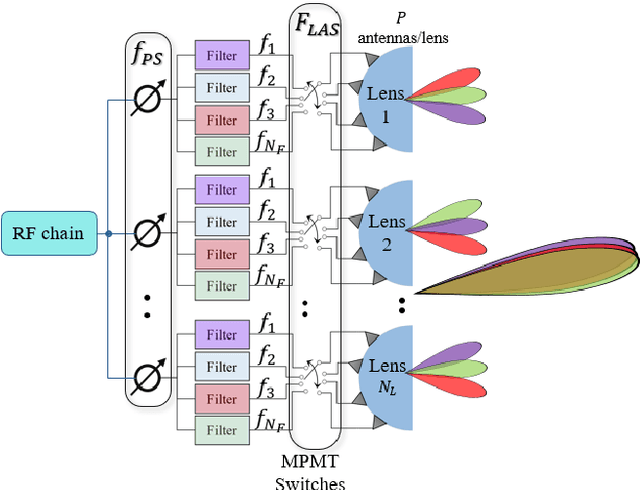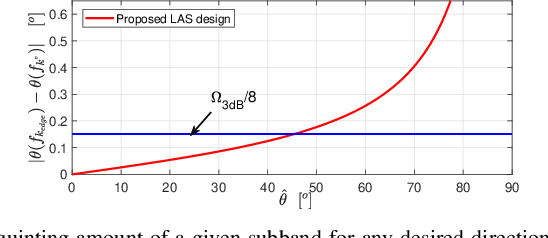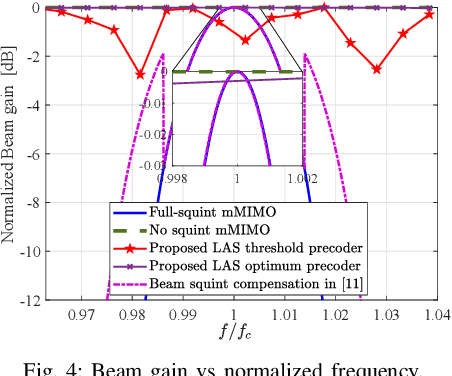Liza Afeef
Polarization-Aware Antenna Selection for Joint Radar and Communication in XL-MIMO Systems
Mar 27, 2025Abstract:A key challenge in dual-polarized multiplexing for joint radar and communication (JRC) systems is cross-polarization (cross-pol) leakage caused by depolarization. In conventional MIMO systems, depolarization arises solely from the channel; however, in XL-MIMO systems, non-stationary properties of the array cause additional polarization shifts at each antenna element, further degrading JRC performance. This paper introduces a channel model incorporating polarization shifts due to the propagation channel and antenna elements in the near-field. We also propose an antenna selection (AS) scheme that dynamically chooses antennas based on polarization imbalance and cross-pol leakage, enhancing spectral efficiency, symbol error rate, and radar detection probability. Simulations show that the proposed AS significantly outperforms traditional methods, providing scalable benefits for XL-MIMO JRC systems.
A High Altitude Platform-Based 3D Geometrical Channel Model for Beamforming Characterization in Future 6G Flying Ad-Hoc Networks
Aug 27, 2024Abstract:Growing requirements of future wireless communication systems, such as high data rates, high reliability, and low latency, make the active usage of Non-Terrestrial Networks (NTN) an inevitable necessity. In this regard, High Altitude Platforms (HAPs) have drawn great attention in recent years due to their unique characteristics such as high coverage, long operational durability, and ad-hoc movement. However, for the active usage of HAPs, channel models for their various usage scenarios must be well-defined, especially in those cases where the sophisticated multiple-input multiple-output (MIMO) techniques, such as beamforming, are utilized to increase the data rate. Therefore, in this study, an air-to-air (A2A) three dimensional (3D) geometrical channel model is proposed to characterize the beamforming capabilities of non-stationary HAP networks operating at millimeter wave (mmWave) frequency band. In this regard, the 3D geometry of the two HAPs in the air is analyzed, and the effect of Doppler due to the movement of HAPs is interrogated as well as its effect on the signal-to-noise ratio (SNR). The final outputs of this study show that the proposed A2A channel model is applicable to characterize the future sixth generation (6G) HAP networks when the mmWave is used to utilize beamforming with a large number of antennas.
Novel Transceiver Design in Wideband Massive MIMO for Beam Squint Minimization
Jul 11, 2022



Abstract:When using ultra-wideband (UWB) signaling on massive multiple-input multiple-output (mMIMO) systems, the electromagnetic wave at each array element incurs an extra propagation delay comparable to (or larger than) the symbol duration, producing a shift in beam direction known as beam squint. The beam squinting problem degrades the array gain and reduces the system capacity. This letter proposes a novel transceiver design based on lens antenna subarray (LAS) and analog subband filters to compensate for the beam squinting effect. In particular, the proposed design aims to divide the UWB signal into narrowband beams and control them with a simplified exhaustive search-based precoding that is proposed to align the beam angle to the target direction. The design is analyzed in terms of beam gain, complexity, power consumption, and capacity, demonstrating significant performance enhancement with respect to the conventional system with uncompensated beam squinting problem.
 Add to Chrome
Add to Chrome Add to Firefox
Add to Firefox Add to Edge
Add to Edge